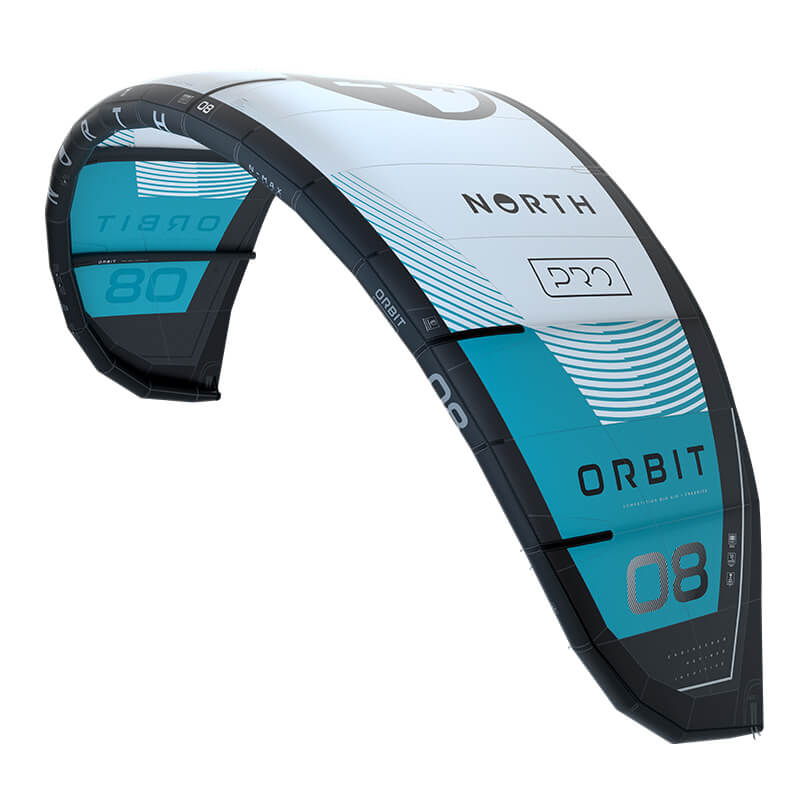When you purchase gear through links on our site, we may earn a small commission. Here’s why you can trust our tests and our affiliate partner.

North are a brand rarely accused of resting on their laurels, and whilst Orbit stands as an already well-proven and widely revered Big Air kite, there’s always potential for improvement, particularly with the rapid-style tangent competition Big Air is taking at the moment with multiple loops in both directions. North have plenty of high profile riders in all the various Big Air competitions and it’s clear this is a factor that’s motivated them to produce a tool specifically for the task, with sizing in one meter increments between 6m and 11m, unapologetically aimed for a comp quiver.
So, let’s explore the technicalities – first up we’ve got the almost obligatory air frame material update, with North employing N-Max material with a modest 13% weight saving but more notably, increased stiffness and response when the material flexes during steering input. It then springs back to shape and does this in a more dynamic manner resulting in a snappier feeling kite. The pulley-free bridle has been completely reworked and now offers increased range over the bar stroke as well as significantly perking up the turning speed. It’s all lean pre-stretched, low-diameter material to minimize parasitic drag.
Over the build, the Orbit has been on a serious strip-down diet and is a prime example of performance-focused minimalism. The bump stops are now lightweight pressed pieces of EVA in essential areas over segment joins. The single-point inflation system only has isolation clamps on the center strut to save weight here. Bladders are the lightest weight available and have been revised across all sizes. The N-Max Dacron is employed minimally around the wingtips. Strut diameters have been reduced and smooth out elegantly into the trailing edge. The canopy has less panels than the standard Orbit reducing the amount of seaming, and the leading edge has a revised smoother design to increase efficiency. The wingtip is slightly more elliptical to aid steering response.
Two steering settings sit right on the outer edge of the wingtip to maximize leverage here. We tested both, and preferred the faster ‘minus’ setting with slightly less bar pressure. The ‘plus’ setting tangibly firms things up for those with bigger guns requiring less assistance. The bar feedback on both settings is excellent as expected, and regardless how inverted or confused you are, the Orbit Pro remains tactile through the bar. 2m line extensions are provided if you want to bring your lines up to 24m total for a little more amplitude on the send.
How does it translate into flying characteristics? The simplest analysis would probably be that the Orbit Pro feels tighter, leaner and more dynamic to handle. Probably the airframe change is most significant, with a far more crisp and energetic character for a five-strut beast. Its position in the wind window sits a smidgen further forward enabling a slightly improved upwind angle as you’d expect from an Orbit on a diet. The bridle seems to concentrate more angle of attack change into a shorter amount of throw at the bar, producing extra lift on a full send and meaning the sweet spot for control seems easily accessible in the middle of the throw and well-trimmed for an average arm length.
Whilst certainly a little faster around the corners, the Orbit Pro provides a similarly reliable nature and retains that reassuringly catchy kiteloop with enough grunt and pull to more than satisfy most mortals. I’m not embarrassed to state firmly that I can’t double kite loop, but even the 9m I tested can whip around so fast that you can certainly feel the potential over the standard Orbit. What caught me unaware was the amount of second lift when you heli-loop on your way down. It whips round fast, and you could really delay initiating the final heli-loop to kiss the water perfectly.
Whilst North’s design intention is very much geared towards top tier and aspiring Big Air riders for the Orbit Pro, we definitely felt that the increase in agility and weight savings perhaps have the unintentional benefit of giving the kite a better application across the performance freeride sector, with the weight savings and increased turning speed enhancing the low end and extending the wind range.
One of the highlights of the existing Orbit 24, was how well it coped with challenging and variable conditions in its top end. The risk in fine-tuning the Orbit and further pointing it towards competition riding would be losing that ease of use in crisis conditions, and its universal appeal. We certainly felt that the reassuring nature of the Orbit remains true to the model’s lineage, and it’s certainly not twitchy and unmanageable, but simply more refined and scalpel-like in its execution. It’s like a VW Golf vs a Golf GTI.
Being this reactive to a rapidly evolving discipline is impressive for a larger brand, and North need to be congratulated for having the R&D agility to chisel and hone an already brilliant Big Air kite in standard form and make it even more dynamic, without losing the reliable character which keeps it so manageable in gnarly conditions. We expect to see it elevating some key individuals on a few significant podiums over the next six months.
